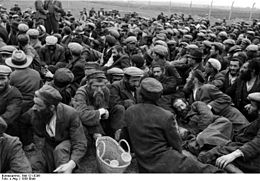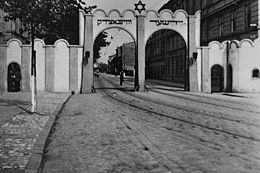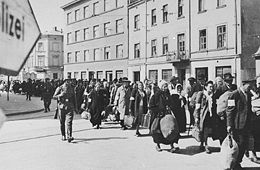- Kraków Ghetto
-
The Kraków Ghetto was one of five major Jewish ghettos created by Nazi Germany in the General Government for the purpose of persecution, terror, and exploitation of Jews during German occupation of Poland in World War II. It was a staging point to begin dividing "able workers" from those who would later be deemed unworthy of life. The Ghetto was liquidated between June 1942 and March 1943, with most of its inhabitants sent to Belzec and Płaszów,[1] and exterminated at Auschwitz concentration camp.
For more details on this topic, see Jewish ghettos in German-occupied Poland.Contents
History
Before the German attack on Poland, Kraków (Cracow) was an influential cultural centre for the 60,000–80,000 Polish Jews who lived there since the 13th century.[2] Persecution of the Jewish population of Kraków began soon after the German troops entered the city on September 1, 1939, in the course of their invasion of Poland. Jews were obliged to take part in forced labor from September on. In November 1939, all Jews 12 years or older were required to wear identifying armbands. Throughout Kraków, synagogues were ordered closed and all their relics and valuables turned over to the Nazi authorities.[2]
By May 1940, the Nazi occupation authority announced that Kraków should become the "cleanest" city in the General Government (an occupied, but unannexed part of Poland). Massive deportation of Jews from the city were ordered. Of the more than 68,000 Jews in Kraków when the Germans invaded, only 15,000 workers and their families were permitted to remain. All other Jews were ordered out of the city, to be resettled into surrounding rural areas.[2]
The Kraków Ghetto was formally established on March 3, 1941 in the Podgórze district, not in the Jewish district of Kazimierz. Displaced Polish families from Podgórze took up residences in the former Jewish dwellings outside the newly established Ghetto. Meanwhile, 15,000 Jews were crammed into an area previously inhabited by 3,000 people who used to live in a district consisting of 30 streets, 320 residential buildings, and 3,167 rooms. As a result, one apartment was allocated to every four Jewish families, and many less fortunate lived on the street.[2]
The Ghetto was surrounded by walls that kept it separated from the rest of the city. All windows and doors that gave onto the "Aryan" side were ordered bricked up. Only four guarded entrances allowed traffic to pass through. In a grim foreshadowing of the near future, these walls contained panels in the shape of tombstones. Small sections of the wall still remain today.
Young people of the Akiva youth movement, who had undertaken the publication of an underground newsletter, HeHaluc HaLohem ("The Fighting Pioneer"), joined forces with other Zionists to form a local branch of the Jewish Fighting Organization (ŻOB, Polish: Żydowska Organizacja Bojowa), and organize resistance in the ghetto, supported by the Polish underground Armia Krajowa. The group carried out a variety of resistance activities including the bombing of the Cyganeria cafe, a gathering place of Nazi officers. Unlike in Warsaw, their efforts did not lead to a general uprising before the ghetto was liquidated.
From May 30, 1942 onward, the Nazis implemented systematic deportations from the Ghetto to surrounding concentration camps. Thousands of Jews were transported in the succeeding months as part of the Aktion Krakau headed by SS-Oberführer Julian Scherner. Jews were assembled on Zgody Square first and then escorted to the railway station in Prokocim. The first transport consisted of 7,000 people, the second, of additional 4,000 Jews deported to Bełżec extermination camp on 5 June 1942. On March 13-March 14, 1943 the final 'liquidation' of the ghetto was carried out under the command of SS-Untersturmführer Amon Göth. Eight thousand Jews deemed able to work were transported to the Plaszow labor camp. Those deemed unfit for work – some 2,000 Jews – were killed in the streets of the ghetto on those days. Any remaining were sent to Auschwitz.[3]
Notable people
Movie director Roman Polanski, a survivor of the Ghetto, evoked his childhood experiences in his memoir, Roman. Polański recalls the early months resembled normalcy; although the peacefulness was sometimes punctuated by fear. Town residents dined out, listened to town bands, and children, such as Polański, socialized in the snow.
Roma Ligocka, Polish artist and author, and a first cousin to Roman Polański who, as a small girl, was rescued and survived the Ghetto, many years later wrote a novel based on her experiences, The Girl in the Red Coat: A Memoir. She is mistakenly thought to be portrayed in the film Schindler's List. The scene, however, was constructed on the memories of Zelig Burkhut, survivor of Plaszow (and other work camps). When being interviewed by Spielberg before the making for the film, Burkhut told of a young girl wearing a pink coat, no older than four, who was shot by a Nazi officer right before his eyes.
The only working pharmacy enclosed within the Kraków Ghetto belonged to Tadeusz Pankiewicz, a Polish pharmacist permitted by the German authorities to operate his "Under the Eagle Pharmacy" there upon his request. In recognition of his heroic deeds in rescuing Jews from the Ghetto he was awarded the title of Righteous Among the Nations by Yad Vashem. Pankiewicz published a book about his time in the ghetto called The Cracow Ghetto Pharmacy (ISBN 0896041158).[3]
Oskar Schindler, a German businessman, came to Kraków because of the labor available from the Ghetto. He selected employees to work in his enamelware plant, and came to view them sympathetically. In 1942, Schindler watched Ghetto inhabitants brutally rounded up for transportation to Płaszów, and subsequently worked furiously to save Jews interned there, events portrayed in the Steven Spielberg film Schindler's List. In an especially dramatic event, 300 of Schindler's workers were deported to the Auschwitz death camp despite his efforts, and he personally intervened to save them.[3]
Mordechai Gebirtig was one of the most influential and popular writers of Yiddish songs and poems. He died there in 1942. Miriam Akavia, an Israeli writer, survived the Kraków ghetto and concentration camps. Renowned dermatologist and co-discoverer of Reyes Syndrome, Dr Jim (Jacob) Baral was also a Krakow Ghetto survivor.
See also
- History of the Jews in Poland
- The Holocaust in Poland
Notes and references
- ^ The statistical data compiled on the basis of "Glossary of 2,077 Jewish towns in Poland" by Virtual Shtetl Museum of the History of the Polish Jews (English), as well as "Getta Żydowskie," by Gedeon, (Polish) and "Ghetto List" by Michael Peters at www.deathcamps.org/occupation/ghettolist.htm (English). Accessed June 21, 2011.
- ^ a b c d History of the Krakow Ghetto with photographs, at www.krakow-poland.com (English) Accessed 12 March 2011.
- ^ a b c JewishKrakow.net - A page on the Krakow Ghetto complete with contemporary picture gallery at the JewishKrakow.net. Accessed 12 March 2011
- About Kraków Ghetto in Polish with valuable historical photos
- Schindler's List - reproduction of the original list of people protected by Oskar Schindler
- Schindler's Krakow - modern-day photographs
- Graf, Malvina (1989). The Kraków Ghetto and the Plaszów Camp Remembered. Tallahassee: The Florida State University Press. ISBN 0813009057
- Polanski, Roman. (1984). Roman. New York: William Morrow and Company. ISBN 0688026214
- Katz, Alfred. (1970). Poland's Ghettos at War. New York: Twayne Publishers. ISBN 0829001956
- Weiner, Rebecca. Virtual Jewish History Tour
 Media related to Kraków Ghetto at Wikimedia Commons
Media related to Kraków Ghetto at Wikimedia CommonsCoordinates: 50°2′43″N 19°57′17″E / 50.04528°N 19.95472°E
The Holocaust in Poland - Main article: The Holocaust
- Related articles by country:
- Belarus
- Estonia
- Latvia
- Lithuania
- Norway
- Russia
- Ukraine
Camps, ghettos and operations Camps ExterminationMass shootings Ghettos - List of 267 Jewish ghettos set up in German-occupied Poland (1939–1942)
- Będzin
- Białystok
- Brest
- Częstochowa
- Grodno
- Kraków
- Lvov (Lwów)
- Łódź
- Lubartów
- Lublin
- Międzyrzec Podlaski
- Radom
- Sosnowiec
- Warsaw
Other atrocities Perpetrators, participants, organizations, and collaborators Major perpetrators Organizers- Josef Bühler
- Eichmann
- Eicke
- Ludwig Fischer
- Hans Frank
- Globocnik
- Glücks
- Greiser
- Himmler
- Hermann Höfle
- Fritz Katzmann
- Wilhelm Koppe
- Friedrich-Wilhelm Krüger
- Kutschera
- Erwin Lambert
- Ernst Lerch
- Oswald Pohl
- Reinefarth
- Scherner
- Seyss-Inquart · Sporrenberg
- Streckenbach
- Thomalla
- Otto Wächter
- Wisliceny
Camp command- Aumeier
- Richard Baer
- Boger
- Braunsteiner
- Eberl
- Kurt Franz
- Karl Frenzel
- Karl Fritzsch
- Göth
- Grabner
- Hartjenstein
- Hering
- Höss
- Hössler
- Josef Kramer
- Liebehenschel
- Maria Mandel
- Matthes
- Michel
- Johann Niemann
- Oberhauser
- Reichleitner
- Heinrich Schwarz
- Stangl
- Gustav Wagner
- Christian Wirth
Gas chamber executioners- Erich Bauer
- Bolender
- Hackenholt
- Klehr
- Hans Koch
- Herbert Lange
Ghetto command- Wolfgang Birkner
- Blobel
- Felix Landau
- Schaper
- Schöngarth
- von Woyrsch
Personnel Camp guardsBy campOrganizations Collaborators JewishEstonian, Latvian,
Lithuanian, Belarusian
and UkrainianOther nationalities- Arajs Kommando
- Ukrainian Auxiliary Police
- Ukrainian collaboration
- Lithuanian Security Police
- Trawniki
- Ypatingasis būrys
- Pieter Menten
Resistance: Judenrat, victims, documentation and technical Organizations Uprisings Leaders Judenrat - Jewish Ghetto Police
- Adam Czerniaków
- Mordechai Chaim Rumkowski
Victim Lists Ghettos- Kraków
- Łódź
- Lvov (Lwów)
- Warsaw
Camps- Auschwitz
- Bełżec
- Chełmno
- Gross-Rosen
- Izbica
- Kraków-Płaszów
- Majdanek
- Sobibor
- Soldau
- Stutthof
- Trawniki
- Treblinka
Documentation Nazi sources- Auschwitz Album
- Frank Memorandum
- Höcker Album
- Höfle Telegram
- Katzmann Report
- Korherr Report
- Nisko Plan
- Posen speeches
- Special Prosecution Book-Poland
- Stroop Report
- Wannsee Conference
Witness accounts- Graebe affidavit
- Gerstein Report
- Vrba-Wetzler report
- Witold's report
ConcealmentTechnical and Logistics - Identification in camps
- Gas chamber
- Gas van
- Holocaust train
- Human medical experimentation
- Zyklon B
Aftermath, trials and commemoration Aftermath Trials West German trials- Frankfurt Auschwitz Trials
- Treblinka trials
Polish, East German, and Soviet trialsMemorials Righteous among the Nations - Polish Righteous among the Nations
- Rescue of Jews by Poles during the Holocaust
- Albert Battel
- Hermann Friedrich Graebe
- Andrey Sheptytsky
- Oskar Schindler
Categories:- Kraków Ghetto
- Jewish ghettos in occupied Poland
- History of Kraków
- Jewish resistance during the Holocaust
Wikimedia Foundation. 2010.







